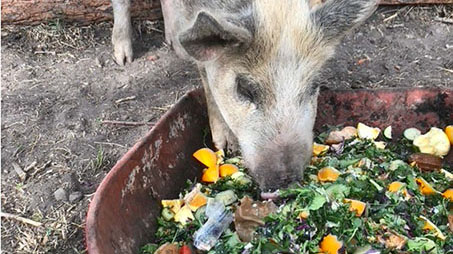Pre-science students turn local food waste into livestock feed
May 21, 2025

Photo courtesy Abe Brown
Abe's pig munches on Taos High School cafeteria leftovers.
Expired edibles = barnyard buffets
Pre-science students turn local food waste into livestock feed
When Abraham “Abe” Brown, a UNM-Taos student pursuing an Associate of Science degree in Pre-Science, realized that his pig’s 5-10 pounds of food-per-day stomach would cost him around $6 a day, he started to consider a less expensive menu.
Living on Abe’s modest Peñasco ranch are one pig, three goats, and a pair of cows, although those numbers fluctuate.
“Since I started collecting farm animals about 5 years ago, I have learned the hard way just how expensive they are to feed. Especially pigs,” he says. “Their saving grace is that they will pretty much eat anything, and they are also a relatively climate-friendly farm animal.”
Fellow student Alexa Pikcilingis lives on a farm north of Taos. She, too, cares for animals: Seven goats—all milking mothers—and a dozen goat kids, two bucks, and chickens. Her neighbor has sheep and ducks.
“All of these animals eat food waste that would otherwise be in the trash,” Alexis says.
Last semester, Abe and Alexis worked together on a food waste grant in which they conducted a food waste audit using the UNM-Taos Thrive Food and Resource Center. Alexis had already spied the expired food at Thrive and immediately saw a great use for it.
“I am a scavenger by default and collect food potential where ever I find it,” Alexis explains. “I have been collecting the expiring food from our food pantry at UNM-Taos all year long. One day last fall when I was in picking up snacks after a math class, I mentioned I’d take the rotting zucchini out of the trash can and feed it to my animals. Since that day, I stop in twice a week and pick up damaged or expiring vegetables, stale grains, and past due cans of food.”
Over the Spring semester, Alexis collected over 200 pounds of trash-bound food from Thrive.
“By collecting what would go into the trash, I am decreasing the daily budget for the animals’ food, and saving the landfill from rotting food waste,” Alexis says. “I enjoy using what is already there. I get a kick out of not letting converted energy go by me.”
Turning to humans, food insecurity is a significant issue in Taos County. Abe believes that consumers, restaurants, schools, and grocery stores waste plenty of food that could, and should, be used to feed people or animals.
However, some laws make it difficult for schools and other institutions to redistribute food to people once it has been served, but Abe says those laws typically don’t apply to farm animals.
So, last fall, with the help of The University of New Mexico Food Waste/Insecurity Reduction project team at Main campus, supported by Sustainable Agriculture Research and Education funding, Abe and the UNM team set out to make connections to divert landfill-bound food into feed livestock.
“On top of the economic impact of feeding livestock, there is also an environmental impact of producing and distributing the grain that should be considered,” Abe adds, especially regarding greenhouse gas emissions. “So, by diverting food waste, we aren’t only reducing the environmental impact of food going to the landfill, but also reducing the environmental impact associated with the feed industry.”
Before being connected with the UNM program, Abe was already collecting spoiled food from La Jicarita Food Bank in Peñasco and UNM-Taos Thrive from “time to time,” but realized he could put more effort into food waste reduction if he had some help.
“Receiving a stipend really helped me put more effort into fostering connections with consumers and opened my schedule to be more available to meet with them to collect their waste,” he explains. “After some networking, I was able to team up with Taos High School and collect food waste from their cafeteria, and in just one day I was able to collect over 100 pounds of food waste.”
That’s enough food to feed his pig for over a week. He also contacted the UNM-Taos Culinary Arts program and established a weekly schedule for collecting their uneaten food.
During the team’s work with Taos High School, they gathered more available data showing the kind of impact they could make if they diverted daily food waste. “Through this experience,” Abe shares, “I was able to dig a little deeper into local food waste sources and make a significantly larger impact in my community than I had before.”
